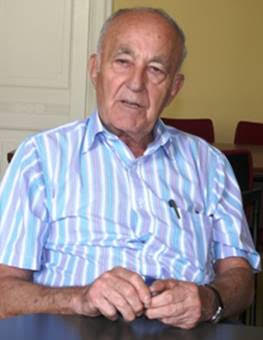
THE VOICE OF INTERNATIONAL LITHUANIA
|
VilNews has its own Google archive! Type a word in the above search box to find any article.
You can also follow us on Facebook. We have two different pages. Click to open and join.
|
Front page
Deportees returning ‘home’ from Siberia
- Posted by - (4) Comment
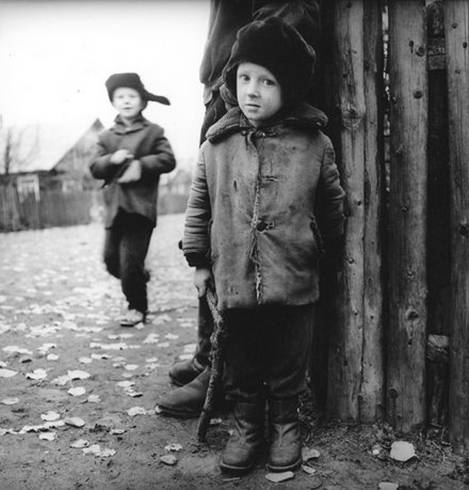
Village street, Dzūkija 1969.
PHOTO: ANTANAS SUTKUS.
It must have been quite a shock for the surviving deportees to return ‘home’ from Siberia to Lithuania in the 1950s and 1960s. The country they had loved and cared so much about was now ruled, mismanaged, by Moscow-believing Communists.
Since 1941 more than 300.000 persons had been deported to Siberia, with tens of thousands dying en route to or on the permafrost. Tens of thousands of the country's leading women and men had fled to America and other nations in the west.
The 1950s was the decade when Lithuania's 10-year guerrilla war against the superior Soviet forces had finally come to an end, with the result that 22.000 Lithuanian forest brothers and about 70.000 Soviet soldiers had lost their lives, thus the longest and bloodiest guerrilla war of modern Europe.
Lithuanian daily life during the 1950s and 1960s was characterized by terrifying KGB activities, denunciations, imprisonments and executions without trial, widespread corruption and mismanagement in which most of the good, democratic principles many fine people had fought so hard for during the interwar period were totally forgotten and disregarded.
People felt despair, discouragement, fear ... But also a vain hope - that Western countries would come to liberate their dear homeland from the Soviet tyranny...
To see more Antanas Sutkus photos, go to:
http://www.ananasamiami.com/2011/04/photography-by-antanas-sutkus.html
- Bookmark :
- Digg
- del.icio.us
- Stumbleupon
- Redit it
- Posted by - (0) Comment
Cultivating Lithuanian unity world-wide:
What YOU can do!

Boris Vytautas Bakunas
By Dr. Boris Vytautas Bakunas, Ph. D., Chicago
A wave of unity swept the international Lithuanian community on March 11th as Lithuanians celebrated the 22nd anniversary of the Lithuanian Parliament’s declaration of independence from the Soviet Union. However, the sense of national unity engendered by the celebration could be short-lived.
Human beings have a strong tendency to overgeneralize and succumb to stereotypical us-them distinctions that can shatter even the strongest bonds. We need only search the internet to find examples of divisive thinking at work:
”50 years of Soviet rule has ruined an entire generation of Lithuanian.”
”Those who fled Lithuania during World II were cowards -- and now they come back, flaunt their wealth, and tell us ‘true Lithuanians’ how to live.”
”Lithuanians who work abroad have abandoned their homeland and should be deprived of their Lithuanian citizenship.”
Could such stereotypical, emotionally-charged accusations be one of the main reasons why relations between Lithuania’s diaspora groups and their countrymen back home have become strained?
As psychiatrist Dr, Aaron T. Beck and others have noted, accusatory remarks are often perceived as threats by those targeted for verbal attack. Recriminations follow and escalate into verbal shooting matches that solidify hostilities between individuals and groups that previously enjoyed friendly relations.
To read more, go to our SECTION 11
- Bookmark :
- Digg
- del.icio.us
- Stumbleupon
- Redit it
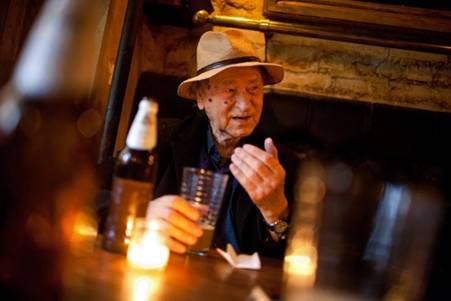
Filmmaker Jonas Mekas has a drink at Cafiero Lussier on East Second Street.
Ramsay de Give for The Wall Street Journal
Now 90 years old, Lithuanian-American filmmaker and archivist Jonas Mekas has spent a third of his life drinking at the Mars Bar in New York. The dive at the corner of Second Avenue and First Street opened in the early 1980s, when Mr. Mekas was busy renovating the future site of his Anthology Film Archives, a block away.
"We came into existence together, so it was friendship," Mr. Mekas said this week, chatting over Lithuanian beer and vodka shots at the Anyway Cafe, one of several East Village bars he frequents more often since Mars Bar closed last June (and was subsequently demolished). The demise of the bar, a refuge for the neighborhood's old-school bohemians, artists and rogues, prompted the filmmaker to edit more than 15 years of casual video footage into "My Mars Bar Movie." It will open a weekend run at Anthology today, Friday 13 April.
Watch the first five minutes of Jonas Mekas’s Mars Bar movie, opening today, Friday 13 April
- Bookmark :
- Digg
- del.icio.us
- Stumbleupon
- Redit it
- Posted by - (0) Comment
Lithuania’s ambassador to the U.S.:
We will never forget or underestimate the role of Lithuanian Americans in our struggle for independence
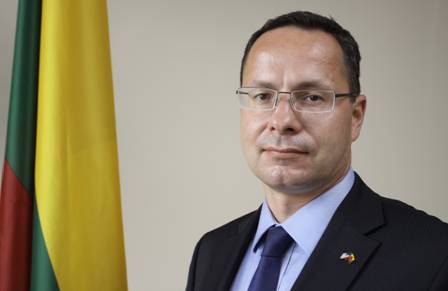
Lithuania’s ambassador to the United States, Žygimantas Pavilionis
Ambassador Žygimantas Pavilionis interviewed by Aage Myhre
Ambassador, you represent Lithuania in the United States, a country where around one million Lithuanians and people of Lithuanian descent live, as citizens of the United States. Are you to a certain degree also their ambassador?
As an ambassador of the Republic of Lithuania, I represent, first of all, interests of my country and my fellow citizens. Not all Lithuanian Americans are citizens of Lithuania, but they, nevertheless, kept close ties to their Homeland and helped greatly to keep memories of independent and free Lithuania alive. All the Lithuanians no matter where their live are equally important share of our nation. This is not only the official position of our Government, but also my personal idea I always had and believed in. Therefore, yes, I am to certain degree their ambassador as well.
Lithuanian-Americans played a significant role in the postwar years, until Lithuania's recovered independence in 1990-1991, by constantly exerting pressure on the U.S. President and leaders in other Western countries so that they would pressure the Soviet Union to allow the Baltic countries freedom after the Soviet occupation taking place during World War II. Now, as more than 20 years have passed since the freedom bells rang, the question is whether the Lithuanian-Americans have a role to play also today? See our article https://vilnews.com/?p=8899
We in Lithuania will never forget and never underestimate the role of Lithuanian Americans in our struggle for independence. It will remain an indispensable part of our history. However, it sounds sometimes a bit strange when I hear that the mission of our countrymen abroad might be over. Not at all! Free, democratic and Western minded Lithuania we fought for and we have now is not the fact that will last forever by itself. On the contrary, we must remember that state-building is a continuous process, which requires our personal everyday efforts. So there are a lot of challenges both in our foreign and domestic policy we are facing now where the help and support from the Lithuanian diaspora is of vital importance. Economy, energy, security issues, education, social affairs– those and many other areas where we need our common work on it. To be more concrete and to illustrate what has been said I would like to name at least two significant projects which our Embassy is going to undertake together with the Lithuanian community in US this year - NATO Summit in May and World Lithuanian Economic Forum in September. Both evens will take place in Chicago, but we do expect an active engagement of Lithuanians from all over United States in them.
“The majority, I believe, are disappointed and discouraged with the present president’s seemingly unfriendly view toward Lithuanian-Americans and others abroad.” This said Regina Narusiene, President of the World Lithuanian Community, in a recent interview (see https://vilnews.com/?p=6704), based on a comment referred to in The Baltic Times, where President Grybauskaite should have said that most prominent U.S. Lithuanian emigres, instead of focusing on developing U.S. - Lithuanian business ties, prefer providing political advice to the Lithuanian authorities, which may not be that necessary nowadays. She was supposedly “disappointed by Lithuanian emigres’ inability to attract U.S.-based investments to Lithuania.” Here in VilNews we often hear Lithuanian-Americans say they do not feel welcome to their home country, and that Lithuania's current president seems to antagonize them. What are the ambassador's comments to this?
I would not like to comment the words of President which I haven’t heard myself, but as far as I’m familiar with the position of President Grybauskaite towards Lithuanian diaspora I could only presume that these words were taken out of the context and that the President didn’t mean at all anything that could be interpreted as an “unfriendly view toward Lithuanian-Americans and others abroad”…
Having said that I might add that Lithuanians are well known in the U.S. for their persistence, hard and committed work and interesting achievements. We know Lithuanians from every generation who became successful politicians, businessmen, artists, social workers, etc. Just look at our honorary consuls – people like Krista Bard or Daiva Navarette are known in their areas of expertise. We also know a lot of Lithuanians from a younger generation who are well established in universities, research labs, have created their businesses. And some of them very successfully extended their business in Lithuania. Do you know that the company “VPA Logistics”, which operate the block train corridor project from Klaipeda to China, called “Sun”, was created by American-Lithuanians from New Jersey? And this project was developed with a great support of the government and the President itself. And there are much more concrete examples were Lithuanian Americans has invested, developed business in Lithuania or with Lithuania, but they have not yet very much advertised that.
| VPA Logistics – excellent example of business venture established by a Lithuanian American Mr. Vytautas ‘Victor’ Paulius is the Lithuanian American who founded the New Jersey company VPA (Vytatuas Paulius Associates) in 1967. UAB VPA was established in Lithuania’s port city Klaipeda in 1996, currently owning & operating over 30,000 sq.m. (320,000 sq.ft.) of state of the art cold storage space located within the Port of Klaipeda and Laistu International Trade Center (LITC), adjacent to Klaipeda State Seaport. VPA Logistics is the company behind the new SUN TRAIN that operates between China and Klaipeda. |
 VYTAUTAS "VICTOR" PAULIUS |
To read more, go to our SECTION 11
- Bookmark :
- Digg
- del.icio.us
- Stumbleupon
- Redit it
The Lithuanian FBI boss and his famous sister
- Posted by - (0) Comment

Many have heard of the legendary Director J. Edgar Hoover who led the FBI from1924 to 1972, but few have heard of the name Alexander Bruce Bielaski who served as the Director of the Federal Bureau of Investigation from 1912 to 1919. FBI was established in 1908, and Bielaski was its second Director.
Even fewer know that Bielaski was of Lithuanian origin. Although his family name was Polonized over time, his family roots can be traced directly back to Lithuania. His grandfather, Captain Alexander Bielaski (Beleskis) had been born on August 1, 1811, in Lithuania.
The FBI Director’s sister, Ruth Bielaski Shipley
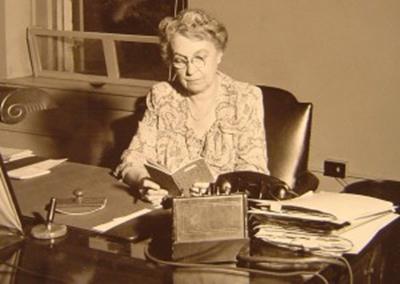
Ruth Bielaski Shipley
Another rather unknown story among Lithuanian Americans, is that Ruth Bielaski Shipley (April 20, 1885 – November 3, 1966) was head of the Passport Division of the United States Department of State for 27 years from 1928 to 1955. In 1951 TIME called her "The most invulnerable, most unfirable, most feared and most admired career woman in the U.S. Government."
- Bookmark :
- Digg
- del.icio.us
- Stumbleupon
- Redit it
- Posted by - (6) Comment
As long as VilNews exists, there is hope for the future
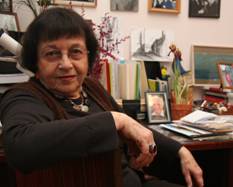 Dr. Irena Veisaite, Chairwoman of the VilNews Honorary Council |
Professor Irena Veisaite, Chairwoman of our Honorary Council, has asked us to convey her heartfelt greetings to the other Council Members and to all readers of VilNews.
“My love and best wishes to all. As long as VilNews exists, there is hope for the future,” she writes. Irena Veisaite means very much for our publication, and we do hereby thank her for the support and wise commitment she always shows. You can read our interview with her HERE. |
- Bookmark :
- Digg
- del.icio.us
- Stumbleupon
- Redit it
- Posted by - (1) Comment
Open letter to Mayor Zuokas from Gene Emmer:
We need playgrounds
in Vilnius Old Town!

Dear Mayor Zuokas,
I live in the Vilnius old town with my wife and young child. We have a small family business and are very happy here. Yet, one thing that concerns us very much is the lack of quality, safe play areas for young children in Vilnius old town. Within the old town there are basically three playgrounds:
Sereikiškės Park: There used to be two play areas. But one was in very bad condition and was removed. The play area which remains is currently the best in the area. But in nice weather it is generally completely full of children.
Vilniaus Gatve: Last year a small wooden park was built near the Šv. Kotrynos Church. It is very simple wooden play area and already needs repairs.
Vokieciu Gatve (behind the Post Office): This is a rundown, playground in very bad condition. It is a night time hangout for drunks and is always full of trash, broken bottles and animal droppings.
As you know, the children of the old town have very few options to walk to recreation, get exercise and breathe fresh air. I was excited to learn recently that you have decided to improve and build several new parks in Vilnius!
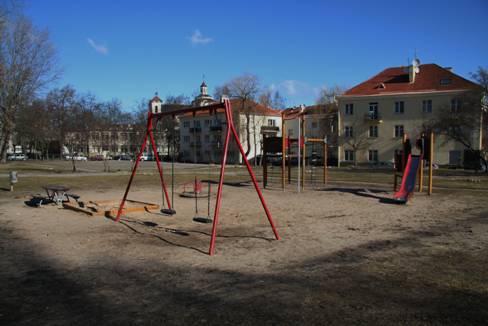
Vokieciu Gatve (behind the Post Office): This is a rundown, playground in very bad condition. It is a night time hangout for drunks and is always full of trash, broken
bottles and animal droppings.
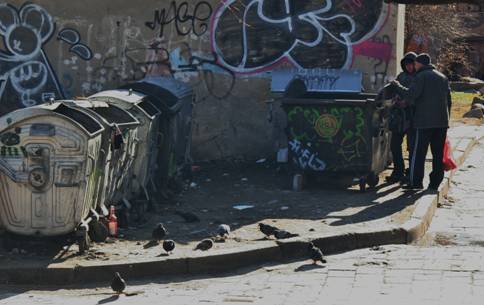
These waste containers are located just 50 meters from the playground at Vokieciu g.. They are a favorite haunt for the homeless and others in search of food residues.
- Bookmark :
- Digg
- del.icio.us
- Stumbleupon
- Redit it
- Posted by - (0) Comment

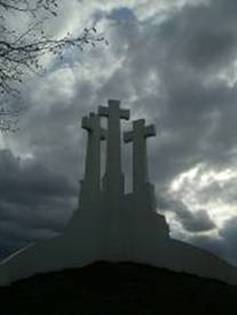
HILL OF THREE CROSSES, VILNIUS
By Aage Myhre
aage.myhre@VilNews.com
Easter Sunday 1991 represents one of the most magical moments I've ever experienced in my life. The date was the 31st of March, and I wandered through the Old Town of Vilnius together with the one who would later become my wife. A couple of months earlier I had been standing with Professor Vytautas Landsbergis in the Lithuanian Parliament looking out at the Soviet military forces and the tens of thousands of Lithuanians who were there with their bonfires and primitive tools to protect the Parliament. I had seen the coffins of the thirteen brave individuals standing outside the Cathedral in Vilnius, and I had seen how a whole people gathered in grief and despair over the USSR's new assault on this small nation and the innocent civilians who so bravely sacrificed their lives for their home country.
- Bookmark :
- Digg
- del.icio.us
- Stumbleupon
- Redit it
- Posted by - (0) Comment
Saulene’s
|
|

Text: Saulene Valskyte
Spring has come, the sun is shining, birds are singing, at least that's what it should be like. In Lithuania Easter weather swings from blizzard to burning sun, but regardless to that is this the most colorful celebration of the year. As all Christian celebrations Easter traditions here are intertwined with paganism, Easter in particulary were a pagan celebration of awakening nature.
The Easter celebration starts a week before Easter Day, on Palm Sunday, when people are gathering in churches with beautiful, colorful, original “palms”. In Lithuania every region have there own palm making traditions, usually palm base are the juniper twig. During the church service the palms are being blessed. Afterwards people participate in a traditional Palm Sunday ritual, beating each other with the blessed palms, wishing each other health and strength. Today this is mostly a children game, but in old days everyone were doing it, singing "It's not me, it's palm what beats you, there's Easter in a week, and you will get an Easter egg".
- Bookmark :
- Digg
- del.icio.us
- Stumbleupon
- Redit it
- Posted by - (0) Comment
- Bookmark :
- Digg
- del.icio.us
- Stumbleupon
- Redit it
- Posted by - (1) Comment
Fleeing from domestic famine in the late 1800's:
Hordes of Lithuanians
came to Pennsylvania
to work in coal mines
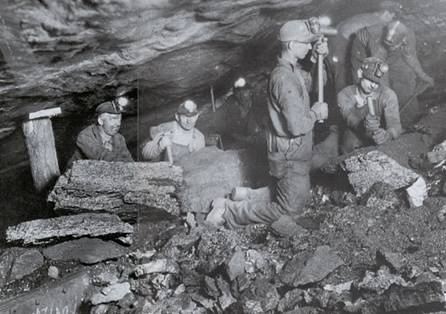
Large numbers of Lithuanians first came to the United States in 1867-1868 after a famine in Lithuania, at that time a part of the Russian Empire after Saint Petersburg had annexed the Lithuanian lands piece by piece between 1772 and 1795 in the partitions of the Polish-Lithuanian Commonwealth between Prussia, (later part of Germany), the Austrian-based Habsburg Monarchy and Czarist Russia, which ceased to exist in 1917-1918.
The beginnings of industrialization and commercial agriculture in the Russian Empire as well as a population boom that exhausted available land transformed Lithuanian peasant-farmers, once considered an immovable fixture of the land, into migrant-labourers. The pressures of industrialization drove numerous Lithuanian peasants to emigrate to the United States continuing until the outbreak of the First World War. This first wave of Lithuanian immigrants to the United States ceased when the US Congress passed the Emergency Quota Act in 1921, followed by the Immigration Act of 1924 driven by xenophobic anti-immigrant attitudes against the newcomers from Eastern Europe. The Immigration Act of 1924 was aimed at restricting the Eastern and Southern Europeans who had begun to enter the country in large numbers beginning in the 1890s.
During the late nineteenth and early twentieth centuries, an estimated 300,000 Lithuanians journeyed to America. This number is hard to document fully because census records did not officially recognize Lithuanians as a separate nationality until the twentieth century, and the country's people may have been reported as Russian, Polish, or Jewish.
Lithuanians differed from most immigrant groups in the United States in several ways. First, they did not plan to remain permanently and become "Americanized." Instead their intent was to live in the US temporarily to earn money, invest in property, and wait for the right opportunity to return to Lithuania. Official estimates were that 30% of the emigrants from the Russian provinces of Poland-Lithuania returned home. When adjusted to include only non-Jews the number is closer to 50-60%. Lithuanian immigrants who mostly came to the United States from Imperial Russia lived in a social environment akin to early European feudal society, where classless Jews performed the essential middle roles of artisans, merchants and moneylenders.
American employers considered Lithuanian immigrants, like the Poles as better suited for arduous manual labour in coal-mines, slaughterhouses, and steel mills, particularly in the primary stages of steel manufacture. Consequently, Lithuanian migrants were recruited for work in the coal mines of Pennsylvania and the heavy industries (steel mills, iron foundries, slaughterhouses, oil and sugar refineries) of the North-eastern United States as well the Great Lakes cities of Chicago, Pittsburgh, Detroit, Buffalo, Milwaukee, and Cleveland.
It is said about Pennsylvania that it was like a Western Lithuania at one point.
To read more, go to our SECTION 11
- Bookmark :
- Digg
- del.icio.us
- Stumbleupon
- Redit it
- Posted by - (0) Comment
Movie Star Charles Bronson (1921-2003)
Son of a Lithuanian
coal miner

Charles Bronson (1921-2003), son of a Lithuanian-Pennsylvanian
coal miner, was born in Ehrenfeld, Pennsylvania, USA
American actor Charles Bronson claimed to have spoken no English at home during his childhood in Pennsylvania. Though he managed to complete high school, it was expected that Bronson would go into the mines like his father and many brothers. Experiencing the world outside Pennsylvania during World War II service, however, Bronson came back to America determined to pursue an art career. While working as a set designer for a Philadelphia theater troupe, Bronson played a few small roles and almost immediately switched his allegiance from the production end of theater to acting.
- Bookmark :
- Digg
- del.icio.us
- Stumbleupon
- Redit it
- Posted by - (0) Comment

The Knights of Lithuania keep on fighting
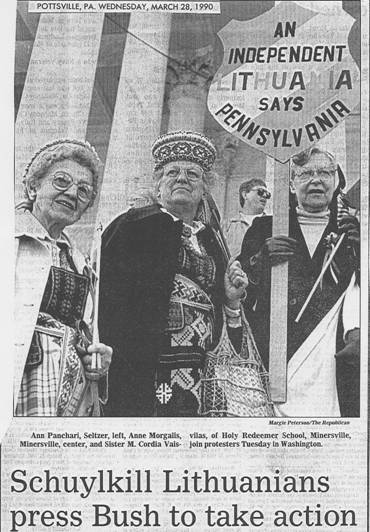
Knights of Lithuania #144 Protesting Washington DC in 1990.
The Knights of Lithuania was founded as a national youth organization in 1913 by Mykolas Norkunas, the “father of the Knights of Lithuania.” Mykolas began his campaign to form a national Lithuanian organization by publishing appeals in the Lithuanian language press in various cities throughout the United States. His purpose was to unite the Lithuanian youth living in the USA, and through them, preserve Lithuanian culture and restore freedom to Lithuania, which was occupied at the time by Russia and Germany. Members placed their hope in their children, which is the basis of the organization. The Knights of Lithuania is a national non-profit organization of dedicated men and women of Lithuanian ancestry. Believing in the strength of the motto: "For God and Country," the Knights of Lithuania aspire to keep alive among its members an appreciation and understanding of the Lithuanian language, customs, and culture, while advancing the values and foundation of the Roman Catholic beliefs.
To read more, go to our SECTION 11
- Bookmark :
- Digg
- del.icio.us
- Stumbleupon
- Redit it
- Posted by - (0) Comment
Sunday 1 April is
Verbų sekmadienis
– Palm Sunday
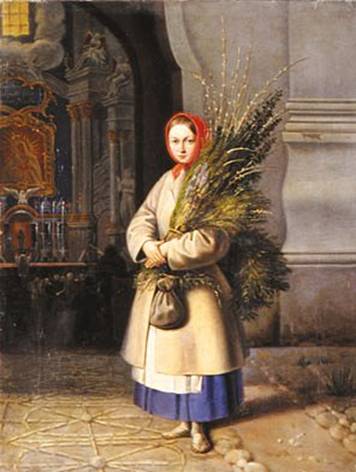
Kanutas Ruseckas (1800–1860).
Lietuvaitė su verbomis (1847)
The Christian world celebrates Jesus' noble entry into Jerusalem on the last Sunday before Easter. In Lithuania this day is called Verbu Sekmadienis – Palm Sunday. When Christianity came to Lithuania, plants which sprouted earliest were honored during spring feasts. Even now, willows, osiers and weeping willows are consecrated on Palm Sunday.
Mythological folklore relates that one of the willows, called Blinde, had been a very fertile woman, bearing numerous children. Earth, the most fertile mother was jealous of her. When Blinde walked through a wetfield, her feet sank into the mud. Blinde turned into a willow tree out of great sadness. The osier, with male spores was regarded as an unusual tree. Folklore tells that the osier grew out of a secretly murdered man. A fife made of osier wood, speaks in a man's voice. Evil spirits avoid it because of its red color. Most palm bunches have a branch of juniper in them. Juniper is green year round, with late ripening berries and with a peculiar odor. All these plants are principal components of palms, however cranberry, mistletoe, filbert and oak branches together with dried baby's breath and ferns are among the odd numbered pieces in the palm. Pussy willows, hepaticas and some indoor plants are added to give color to the palms. When Christianity was established in Lithuania, palms were consecrated in church. The ancient tradition of whipping each other with palms, still exists, takes place on Palm Sunday or on Easter Sunday.
- Bookmark :
- Digg
- del.icio.us
- Stumbleupon
- Redit it
- Posted by - (0) Comment
“Our ancestors always whisper in our ears, they beg to be understood”
 |
Last week we brought an article with the latest statistics from the World Health Organization, showing that Lithuania again is on top when it comes to suicides – with 61,3 men and 10,4 women per 100,000 inhabitants deciding to end their lives this sad way – annually.
Dainius Puras, a Lithuanian psychiatrist, explains how it is the uncertainty and unpredictability of the economic situation that have such a detrimental effect: "People don't like change,” he says, referring to Lithuania’s 20-year period of dramatic social and economic change since the fall of the Soviet Union in 1991”. |
Response from Vijole Arbas in Kaunas:
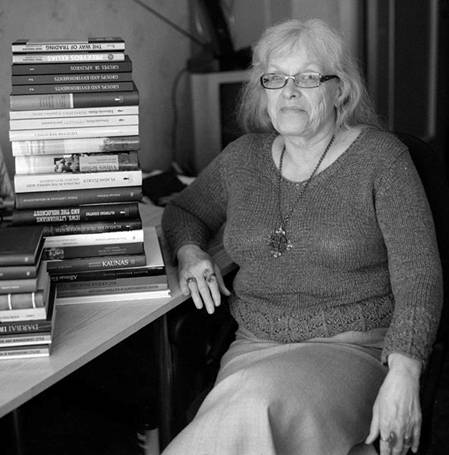
This cannot be the only explanation -- we are plagued by bad spirits of our past, we can't seem to "clean up", to make amends.
Jūratė Sučylaitė wrote a novel (can't recall the exact title Pokalbis su Ragana, somthing like that). Her thesis (if I may call it that) is that our ancestors always whisper in our ears. They beg to be understood. That does not mean to glorify but understand, realize why, forgive, make amends. People want to drown out those voices of the dead by alcoholism, suicide. It is a haunting story that rings very true to me.
On the other hand, the ancestors of American Lithuanians also whisper, also had the sins of betrayal against one's fellow man as well as of victimization. Why don't they hear those ghosts?
A film by V. Landsbergis Jr., When I Was a Partisan, also deals with this sort of concept.
 |
Irene Simanavicius: There is so much more to this...so much more. Those of us that grew up in North America and have visited Lithuania got to know and love people we have met during our visits. People young and old shared some of the stories that were heart wrenching. I agree with Vijole Arbas 100 %. |
- Bookmark :
- Digg
- del.icio.us
- Stumbleupon
- Redit it
Happy Stork Day!!
- Posted by - (1) Comment
|
The white stork (gandras) is usually felt to be the national bird of Lithuania. Lithuanians believe that storks bring harmony to the families on whose property they nest; they have also kept up the tradition of telling their children that storks bring babies. Stork Day is celebrated on 25 March with various archaic rituals: gifts for children, attributed to the storks, such as fruits, chocolates, pencils, and dyed eggs, which are hung on tree branches and fences; snakes are caught, killed and buried under the doorstep; straw fires are lit. Notably, Lithuania is a beneficial and important habitat for these birds: it has the highest known nesting density in the world! |
 |
- Bookmark :
- Digg
- del.icio.us
- Stumbleupon
- Redit it
VilNews e-magazine is published in Vilnius, Lithuania. Editor-in-Chief: Mr. Aage Myhre. Inquires to the editors: editor@VilNews.com.
Code of Ethics: See Section 2 – about VilNews. VilNews is not responsible for content on external links/web pages.
HOW TO ADVERTISE IN VILNEWS.
All content is copyrighted © 2011. UAB ‘VilNews’.

 Click on the buttons to open and read each of VilNews' 18 sub-sections
Click on the buttons to open and read each of VilNews' 18 sub-sections 









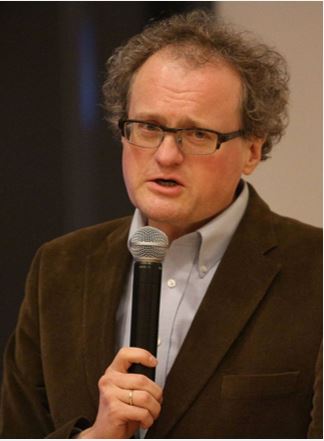

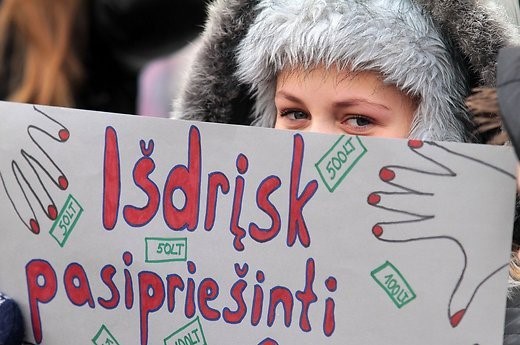


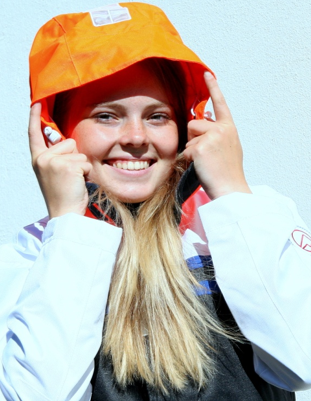
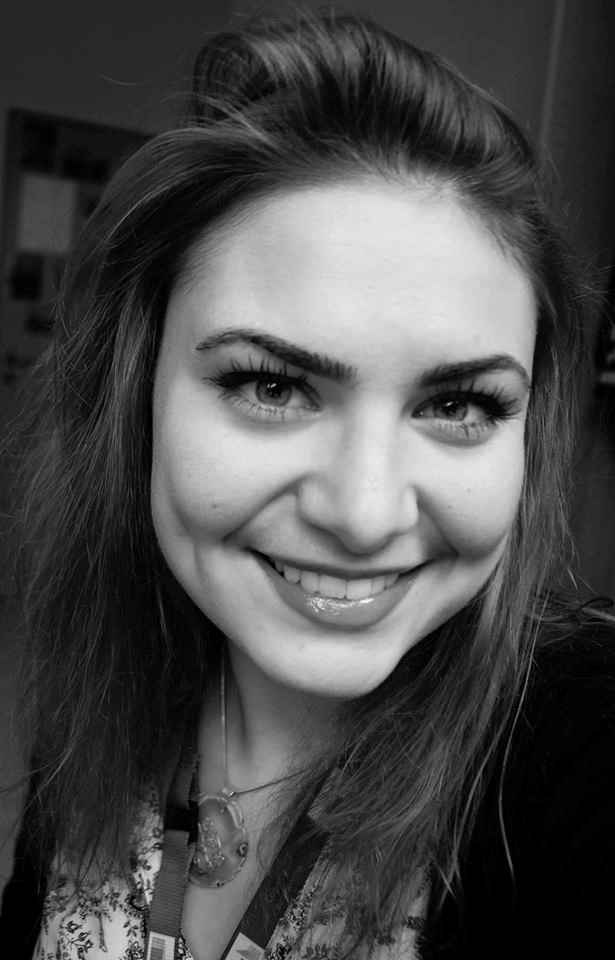

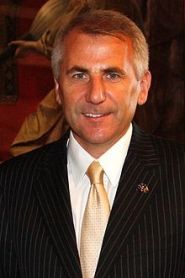
.jpg)
